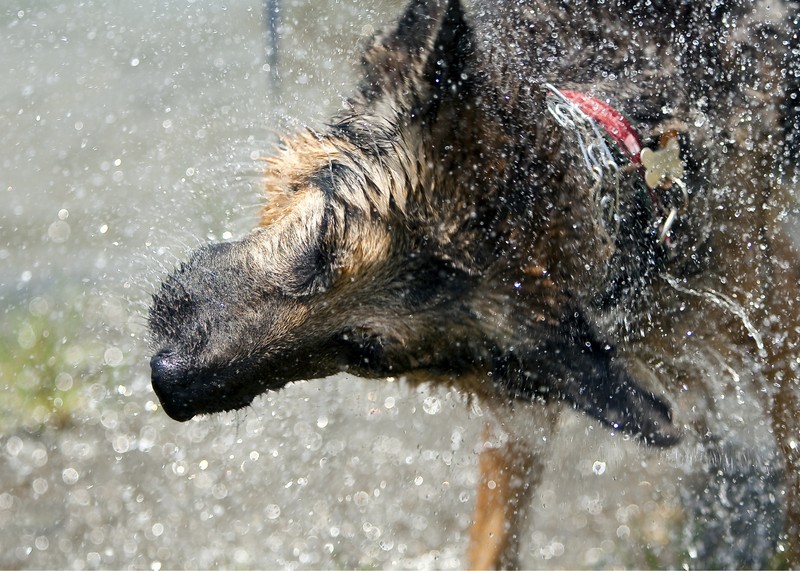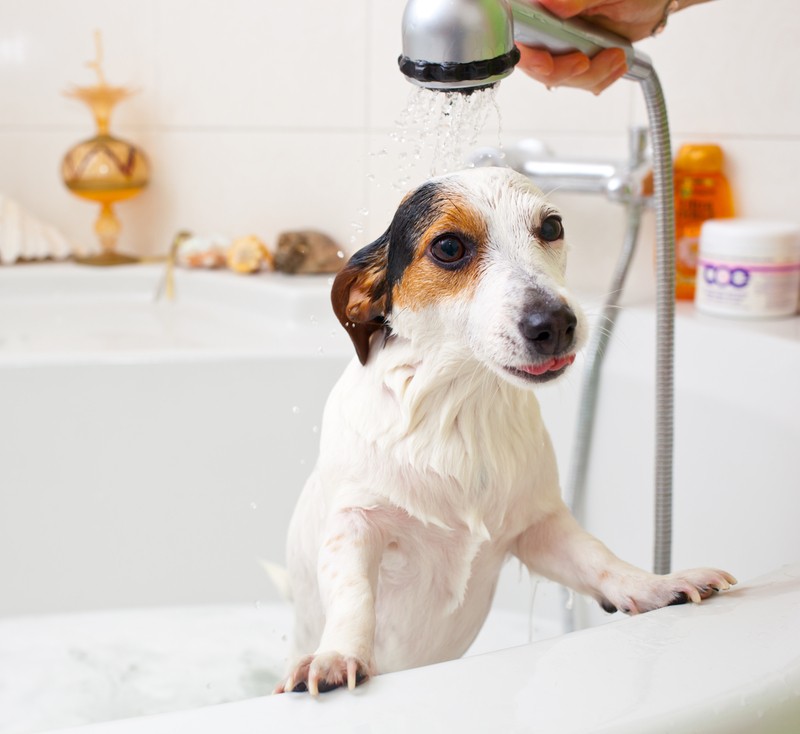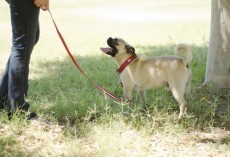Before bath time some dogs get so scared they may start barking, shaking, and in severe cases, even try to bite you. Don't blame your pup if they are having issues with getting wet and clean, because chances are they just don't associate getting clean with something fun or rewarding. You can still train your dog to enjoy bath time though. Here are some tips to point you in the right direction:
Here’s how to give your dog a good scrubbing, using techniques that make the process as easy and stress-free as possible for you and your pet.
Bath Time’s the Best!
No matter what age, size, sex or breed of dog you have, you can make bathing a pleasant part of your dog’s life if you do two things:
1. Teach your dog to associate bathing with things he loves.
2. Take it slow and easy.Associate Bathing with Good Things
The secret is to teach your dog that bathing is always followed by things he loves. If your dog learns that bath time reliably leads to wonderful stuff—like special treats, brand-new chew toys, the start of a favorite game, a walk in the park or dinnertime—he’ll soon learn to feel much better about it. And if he feels much better about getting a bath, he’ll behave better too, which will make bath time easier for both of you.
Take It Slow and Easy
Take time to gradually introduce your dog to bathing. Before giving him a bath, spend a couple of days just taking him into the bathroom, putting him in the tub, giving him a few tasty treats and then taking him out again. Spend a few more days turning on the water or the sprayer before giving your dog his treats—but don’t give him an actual bath yet. You’re just getting him used to the sensations and sounds involved in bathing.
About Puppies
If you get your puppy used to regular bathing now, bathing him as an adult will be a breeze. Follow the guidelines above with your puppy.
Time for a Bath
Because of their activities, breed types, or individual skin or coat types, some dogs need baths more often than others.
Before You Start
• First things first: you’ll need to find a good shampoo. Pet stores carry an array of shampoos and conditioners. The best way to choose one is to consult your dog’s veterinarian or a professional groomer.
• Brush your dog’s coat to remove loose fur and tangles. This can reduce the amount of fur your dog sheds during the bath and prevent additional tangles, which can be painful to comb out.
• Avoid calling your dog to come to you when you’re about to bathe him. Coming when called should always result in rewards for your dog. If you call him, he comes running and then something unpleasant happens to him (like a bath), he’ll learn not to come.
Teaching Your Dog to Get In and Get Out
You’ll teach your dog two cues: “Get in” and “Get out.” Start by preparing some tasty treats, such as small pieces of chicken, cheese or hot dog. Show your dog a treat.
1. Say your cue, “Get in.”
2. Toss the treat into the box. When your dog steps into the box, say “Good!” and give him another treat.
3. Then say “Get out,” and clap your hands and move away to encourage your dog to step out of the box. You can praise him when he does, but you don’t need to treat him. It’s best to convince him that it’s the most fun to get into the box (and later the tub).Repeat these steps about 10 times. Take a break for a few minutes, and then practice another set of 10 repetitions. After your second set, end the training session. Practice the steps above for two or three days. Aim to have a couple of training sessions per day.
Now that your dog has practiced following a treat into the box, ask him to go in before rewarding him with the treat.
1. To warm up, do a couple of repetitions just like you did before—throwing the treat into the box so that your dog follows it. Then change the rules a little.
2. Say “Get in,” and point to the box instead of throwing a treat into it. (When you point to the box, it might help to move your arm like you did when tossing a treat into the box. A similar motion can remind your dog what you want him to do.)
3. Wait until your dog goes in. When he does, praise him and immediately give him a couple of treats while he’s still in the box.
4. Then say “Get out,” and encourage your dog to come out of the box.Do 10 repetitions and take a short break. Repeat the exercise 10 more times, or until your dog knows the game and readily steps in and out of the box when you ask him to.
Now you’re ready to move your training sessions to the bathroom.
1. Say “Get in,” and point to the tub. (The first few times you give the cue, you might need to toss a treat into the tub to show him what he’s supposed to do.)
2. When your dog jumps in the tub, praise him lavishly and immediately give him a few treats.
3. Say “Get out,” and encourage your dog to jump out of the tub.Repeat the steps above 10 times. Take a short break, and then do another set of 10 repetitions. After your second set, end the training session and give your dog an extra-special treat or chew bone, or play his favorite game with him.
Wet, Lather, Rinse and Dry
Before turning on the water, you can gently place a large cotton ball in each of your dog’s ears to keep them free of moisture.
Be careful to avoid getting water or shampoo into your dog’s ears, eyes and mouth.
After the bath, it’s time to thoroughly dry your dog.
A word of warning: it’s normal for dogs to rub themselves on the carpet, furniture or the ground after a bath. If you’re concerned about your couch getting wet or your dog getting covered in lawn clippings or dirt, keep him confined in a safe area like your kitchen, until he’s totally dry.
The Post-Bath Party
Now that you’ve finished bathing your dog, celebrate to make sure your dog thinks that bath time always leads to fun for him.
Bathing Alternatives
If you can’t or don’t want to use your bathtub to bathe your dog, try one of the following ideas instead:
• If you’ve got a medium-sized or larger dog, you can bathe him in the shower. It’s much easier for dogs to step into showers without tubs.
• If it’s warm enough, try bathing your dog outside. You can use a plastic kiddy pool or a regular hose.
• If you have a small dog, you can bathe him in a kitchen or utility sink. You won’t have to bend over, and your dog won’t have to get into a big bathtub, which might scare him. You can use the kitchen-sink sprayer to conveniently wet and rinse your dog!
• You can purchase a special tub made specifically for bathing dogs, such as the Scrub-a-Dub Dog Tub.
• Some pet-care businesses, such as boarding kennels, day cares and groomers, offer do-it-yourself dog wash stations
• If your dog really dislikes bathing, only bathe him when absolutely necessary. Instead of getting him wet, brush him daily and use a damp cloth to wipe stubborn dirt off of his fur and paws.
As you just read there are several ways to train a dog to get used to and perhaps even enjoy being bathed. There are the occasional pets that will have extreme anxiety before and during bathtime, so in cases like these you may need to consult with a behavior specialist. In addition to the helpful tips above, ASPCA discusses these more in detail. We hope you have a happy and positive experience bathing FIDO!











